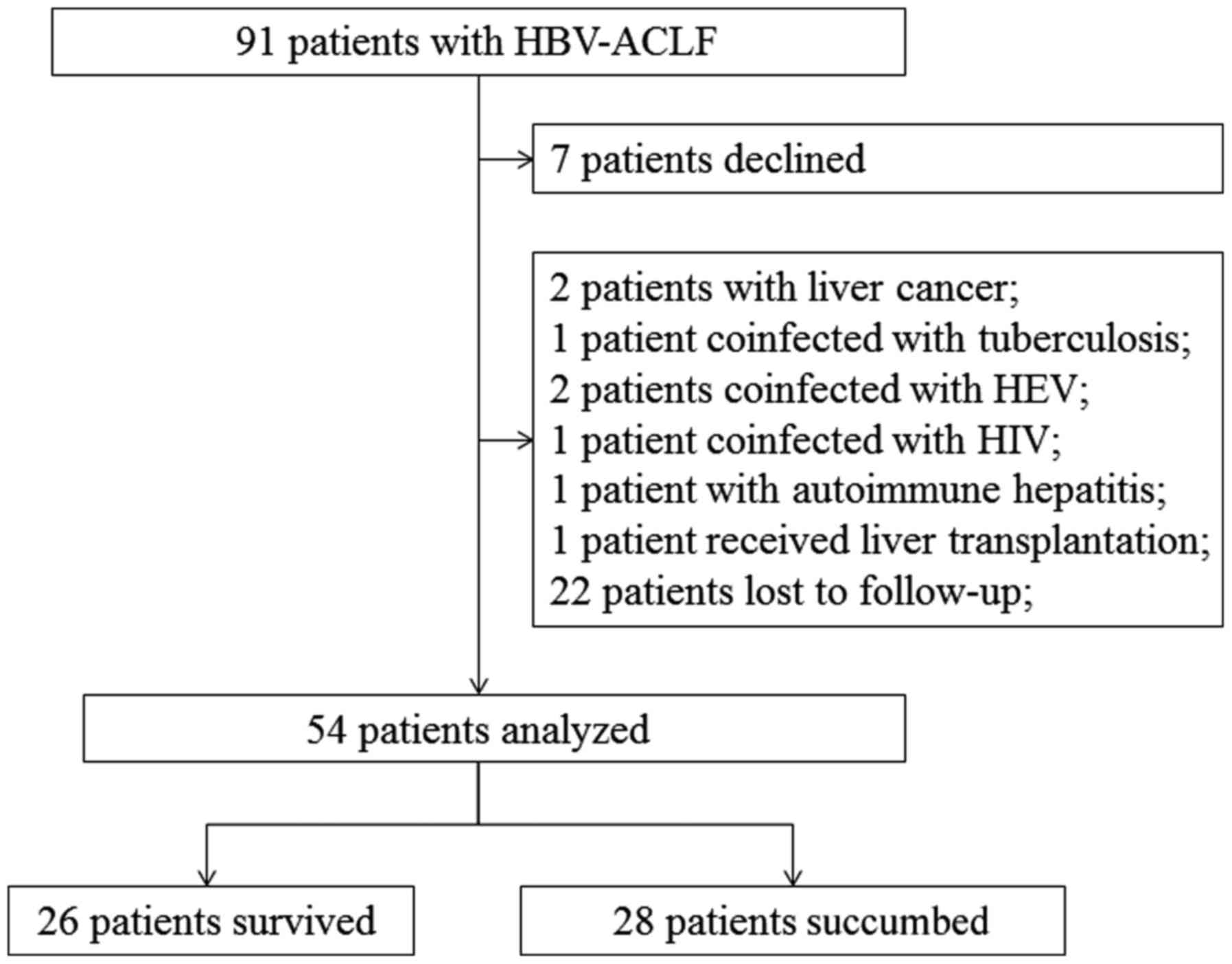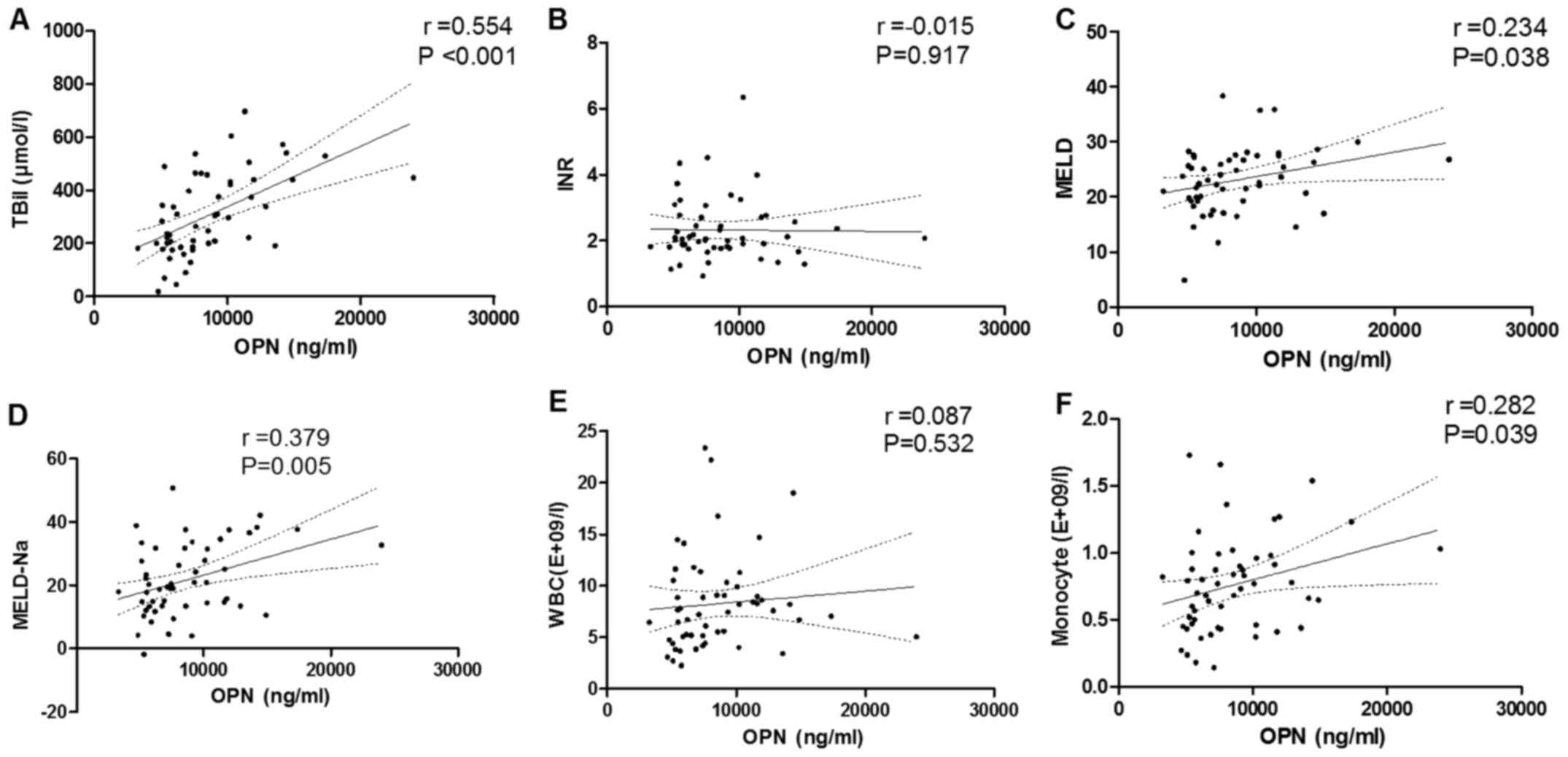|
1
|
Hernaez R, Solà E, Moreau R and Ginès P:
Acute-on-chronic liver failure: An update. Gut. 66:541–553. 2017.
View Article : Google Scholar : PubMed/NCBI
|
|
2
|
Arroyo V and Jalan R: Acute-on-chronic
liver failure: Definition, diagnosis, and clinical characteristics.
Semin Liver Dis. 36:109–116. 2016. View Article : Google Scholar : PubMed/NCBI
|
|
3
|
Arroyo V and Moreau R: Diagnosis and
prognosis of acute on chronic liver failure (ACLF) in cirrhosis. J
Hepatol. 66:451–453. 2017. View Article : Google Scholar : PubMed/NCBI
|
|
4
|
Kamath PS, Wiesner RH, Malinchoc M,
Kremers W, Therneau TM, Kosberg CL, D'Amico G, Dickson ER and Kim
WR: A model to predict survival in patients with end-stage liver
disease. Hepatology. 33:464–470. 2001. View Article : Google Scholar : PubMed/NCBI
|
|
5
|
Biggins SW, Kim WR, Terrault NA, Saab S,
Balan V, Schiano T, Benson J, Therneau T, Kremers W, Wiesner R, et
al: Evidence-based incorporation of serum sodium concentration into
MELD. Gastroenterology. 130:1652–1660. 2006. View Article : Google Scholar : PubMed/NCBI
|
|
6
|
Diao H, Iwabuchi K, Li L, Onoe K, Van Kaer
L, Kon S, Saito Y, Morimoto J, Denhardt DT, Rittling S, et al:
Osteopontin regulates development and function of invariant natural
killer T cells. Proc Natl Acad Sci USA. 105:pp. 15884–15889. 2008;
View Article : Google Scholar : PubMed/NCBI
|
|
7
|
Diao H, Kon S, Iwabuchi K, Kimura C,
Morimoto J, Ito D, Segawa T, Maeda M, Hamuro J, Nakayama T, et al:
Osteopontin as a mediator of NKT cell function in T cell-mediated
liver diseases. Immunity. 21:539–550. 2004. View Article : Google Scholar : PubMed/NCBI
|
|
8
|
Pereira TA, Syn WK, Pereira FE,
Lambertucci JR, Secor WE and Diehl AM: Serum osteopontin is a
biomarker of severe fibrosis and portal hypertension in human and
murine schistosomiasis mansoni. Int J Parasitol. 46:829–832. 2016.
View Article : Google Scholar : PubMed/NCBI
|
|
9
|
Matsue Y, Tsutsumi M, Hayashi N, Saito T,
Tsuchishima M, Toshikuni N, Arisawa T and George J: Serum
osteopontin predicts degree of hepatic fibrosis and serves as a
biomarker in patients with hepatitis C virus infection. PLoS One.
10:e01187442015. View Article : Google Scholar : PubMed/NCBI
|
|
10
|
Zhao L, Li T, Wang Y, Pan Y, Ning H, Hui
X, Xie H, Wang J, Han Y, Liu Z, et al: Elevated plasma osteopontin
level is predictive of cirrhosis in patients with hepatitis B
infection. Int J Clin Pract. 62:1056–1062. 2008. View Article : Google Scholar : PubMed/NCBI
|
|
11
|
Fan X, He C, Jing W, Zhou X, Chen R, Cao
L, Zhu M, Jia R, Wang H, Guo Y, et al: Intracellular Osteopontin
inhibits toll-like receptor signaling and impedes liver
carcinogenesis. Cancer Res. 75:86–97. 2015. View Article : Google Scholar : PubMed/NCBI
|
|
12
|
Patouraux S, Rousseau D, Rubio A,
Bonnafous S, Lavallard VJ, Lauron J, Saint-Paul MC, Bailly-Maitre
B, Tran A, Crenesse D, et al: Osteopontin deficiency aggravates
hepatic injury induced by ischemia-reperfusion in mice. Cell Death
Dis. 5:e12082014. View Article : Google Scholar : PubMed/NCBI
|
|
13
|
Liu Y, Cao L, Chen R, Zhou X, Fan X, Liang
Y, Jia R, Wang H, Liu G, Guo Y, et al: Osteopontin Promotes Hepatic
Progenitor Cell Expansion and Tumorigenicity via Activation of
β-Catenin in Mice. Stem Cells. 33:3569–3580. 2015. View Article : Google Scholar : PubMed/NCBI
|
|
14
|
Lee SH, Park JW, Woo SH, Go DM, Kwon HJ,
Jang JJ and Kim DY: Suppression of osteopontin inhibits chemically
induced hepatic carcinogenesis by induction of apoptosis in mice.
Oncotarget. 7:87219–87231. 2016.PubMed/NCBI
|
|
15
|
Srungaram P, Rule JA, Yuan HJ, Reimold A,
Dahl B, Sanders C and Lee WM: Acute Liver Failure Study Group:
Plasma osteopontin in acute liver failure. Cytokine. 73:270–276.
2015. View Article : Google Scholar : PubMed/NCBI
|
|
16
|
Tajiri T, Tate G, Kunimura T, Endo Y,
Inoue K, Mitsuya T, Morohoshi T and Yoshiba M: Osteopontin
expression in proliferated bile ductules: The correlation with
liver damage in fulminant hepatitis. Dig Dis Sci. 50:188–195. 2005.
View Article : Google Scholar : PubMed/NCBI
|
|
17
|
Arai M, Yokosuka O, Kanda T, Fukai K,
Imazeki F, Muramatsu M, Seki N, Miyazaki M, Ochiai T, Hirasawa H,
et al: Serum osteopontin levels in patients with acute liver
dysfunction. Scand J Gastroenterol. 41:102–110. 2006. View Article : Google Scholar : PubMed/NCBI
|
|
18
|
Sarin SK, Kedarisetty CK, Abbas Z,
Amarapurkar D, Bihari C, Chan AC, Chawla YK, Dokmeci AK, Garg H,
Ghazinyan H, et al: APASL ACLF Working Party: Acute-on-chronic
liver failure: Consensus recommendations of the Asian Pacific
Association for the Study of the Liver (APASL) 2014. Hepatol Int.
8:453–471. 2014. View Article : Google Scholar : PubMed/NCBI
|
|
19
|
Tang CM, Yau TO and Yu J: Management of
chronic hepatitis B infection: Current treatment guidelines,
challenges, and new developments. World J Gastroenterol.
20:6262–6278. 2014. View Article : Google Scholar : PubMed/NCBI
|
|
20
|
Graupera I, Solà E, Fabrellas N, Moreira
R, Solé C, Huelin P, de la Prada G, Pose E, Ariza X, Risso A, et
al: Urine Monocyte Chemoattractant Protein-1 Is an Independent
Predictive Factor of Hospital Readmission and Survival in
Cirrhosis. PLoS One. 11:e01573712016. View Article : Google Scholar : PubMed/NCBI
|
|
21
|
Duarte-Salles T, Misra S, Stepien M,
Plymoth A, Muller D, Overvad K, Olsen A, Tjønneland A, Baglietto L,
Severi G, et al: Circulating osteopontin and prediction of
hepatocellular carcinoma development in a large European
population. Cancer Prev Res (Phila). 9:758–765. 2016. View Article : Google Scholar : PubMed/NCBI
|
|
22
|
Rastogi A, Bihari C, Maiwall R, Ahuja A,
Sharma MK, Kumar A and Sarin SK: Hepatic stellate cells are
involved in the pathogenesis of acute-on-chronic liver failure
(ACLF). Virchows Arch. 461:393–398. 2012. View Article : Google Scholar : PubMed/NCBI
|
|
23
|
Shih SC, Ho TC, Chen SL and Tsao YP:
Pigment epithelium-derived factor (PEDF) peptide promotes the
expansion of hepatic stem/progenitor cells via ERK and
STAT3-dependent signaling. Am J Transl Res. 9:1114–1126.
2017.PubMed/NCBI
|
|
24
|
Wang G, Zhao C, Chen S, Li X, Zhang L,
Chang C and Xu C: A preliminary in vivo study of the effects of OPN
on rat liver regeneration induced by partial hepatectomy. Mol Biol
Rep. 43:1371–1382. 2016. View Article : Google Scholar : PubMed/NCBI
|
|
25
|
Urtasun R, Lopategi A, George J, Leung TM,
Lu Y, Wang X, Ge X, Fiel MI and Nieto N: Osteopontin, an oxidant
stress sensitive cytokine, up-regulates collagen-I via integrin
α(V)β(3) engagement and PI3K/pAkt/NFκB signaling. Hepatology.
55:594–608. 2012. View Article : Google Scholar : PubMed/NCBI
|
|
26
|
Wang X, Lopategi A, Ge X, Lu Y, Kitamura
N, Urtasun R, Leung TM, Fiel MI and Nieto N: Osteopontin induces
ductular reaction contributing to liver fibrosis. Gut.
63:1805–1818. 2014. View Article : Google Scholar : PubMed/NCBI
|
|
27
|
Coombes JD, Swiderska-Syn M, Dollé L, Reid
D, Eksteen B, Claridge L, Briones-Orta MA, Shetty S, Oo YH, Riva A,
et al: Osteopontin neutralisation abrogates the liver progenitor
cell response and fibrogenesis in mice. Gut. 64:1120–1131. 2015.
View Article : Google Scholar : PubMed/NCBI
|
|
28
|
Strazzabosco M, Fabris L and Albano E:
Osteopontin: A new player in regulating hepatic ductular reaction
and hepatic progenitor cell responses during chronic liver injury.
Gut. 63:1693–1694. 2014. View Article : Google Scholar : PubMed/NCBI
|
|
29
|
Uede T: Osteopontin, intrinsic tissue
regulator of intractable inflammatory diseases. Pathol Int.
61:265–280. 2011. View Article : Google Scholar : PubMed/NCBI
|
|
30
|
Inoue M and Shinohara ML: Intracellular
osteopontin (iOPN) and immunity. Immunol Res. 49:160–172. 2011.
View Article : Google Scholar : PubMed/NCBI
|
|
31
|
Nagoshi S: Osteopontin: Versatile
modulator of liver diseases. Hepatol Res. 44:22–30. 2014.
View Article : Google Scholar : PubMed/NCBI
|

















